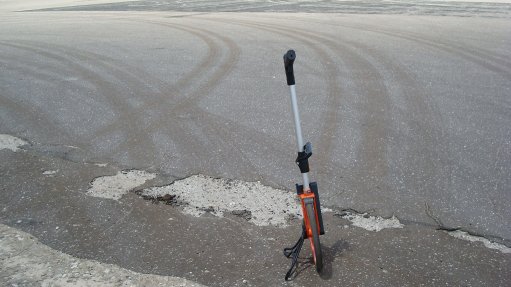
JG Afrika, a leading South African consulting engineering company, recently developed an Airport Pavement Management System (APMS) for Namibia Airports Company (NAC).
Notably, this is the first comprehensive inventory and description of all NAC’s airside paved assets, and a step taken towards the development of a larger Integrated Infrastructure Asset Management System.
Led by Dr Emile Horak, a well-known pavement specialist with an extensive background in airport infrastructure, JG Afrika undertook a visual assessment of all eight airports in 2017. The draft format of the report, which describes the condition of the paved assets, was concluded at the end of 2017.
NAC has eight airports under its operational control, with Hosea Kutako International Airport, situated 48 km from the capital, Windhoek, serving as the gateway into Namibia. The medium-size Eros Airport, located within Windhoek city, accommodates smaller aircrafts, and regional flights are also undertaken from the Walvis Bay International Airport.
Of the other five regional aerodromes, only Luderitz operates successfully as a fit-for-purpose airport. The remainder, situated at Ondangwa, Katima Mulio, Rundu and Keetmanshoop, were originally built by the South African military under the previous dispensation and are now used by the government for commercial purposes. However, the landside and airside infrastructure provided by military operations are not adequate for commercial use, despite low air traffic movement and passenger numbers.
For example, ex-military airports catered for getting boots-on-the-ground rather than for passenger comfort, and consequently these airports do not have terminal buildings that can be readily converted into civilian-friendly facilities.
Exacerbating the situation is the significant superfluous capacity regarding apron areas, length of runways, extra taxiways, and so forth, all of which add to the complexity and cost of maintenance.
It is an ongoing challenge for the NAC to maintain these ex-military airports as viable commercial operations without incurring significant upgrading costs, even as they face substantial maintenance backlogs.
To this end, JG Afrika produced a draft Policy and Management of Airport Pavement Maintenance document for NAC. In line with international practice, the document motivates the acceptance of the policy and the continued development and use of the APMS.
This is in addition to a minimum service level classification in line with the Civil Aviation Organisation (ICAO) Aerodrome classification system that provides trigger values and best practice benchmarks for maintenance and rehabilitation for the various airports and their airside elements.
Dr Horak says that the APMS provides NAC with a holistic view of its airside infrastructure to better plan and motivate maintenance.
“Our report encourages the NAC to reduce the maintenance burden by bringing airside infrastructure in line with the civilian and commercial needs of the airport. This would necessitate ‘mothballing’ specified airside infrastructure, allowing the loss-leader airports to be managed more cost effectively,” says Dr Horak.
He adds that it has become international best practice for airport companies to develop and maintain APMS to appropriately reflect the full airside asset portfolio inventory, current condition assessment and projected or modelled future deterioration over time.
Worldwide, it is accepted that asset management or ‘curator’ authorities need to manage their portfolio of both old and new physical assets in such a manner that they are affordable. Typically, new assets cannot simply be acquired while older infrastructure is neglected. This approach increases the average age of the total assets over time and leads to an unaffordable backlog in maintenance.
Moreover, Dr Horak notes that airside asset condition has a direct bearing on airport operational safety. Safety guidelines and oversight is provided by various international airport safety and operational organisations, such as the ICAO.
The ICAO, US-based Federal Aviation Authority or the National Namibian Civil Aviation Authority often conduct safety audits against inventory and condition assessments in the same format as reported in a required functional APMS.
The APMS is run using Micro-PAVER software, an internationally accepted tool for pavement inspection. Notably, it features a Geographic Information System (GIS) to provide NAC with the exact location of every element or sub-element of the surfaced areas of the airports. The GIS actually acts as an inventory that describes each surface element in exact detail regarding size and geo-referencing of typically simply defined polygons of each element or sub-element. Horak explains that such a GIS inventory is a basic requirement for any type of modern road or pavement management system.
The Pavement Condition Index (PCI), an internationally-accepted standard, rates the condition of the airside infrastructure. The ratings range from “satisfactory”, “fair”, “poor”, “very poor”, “serious” and “failed”.
Furthermore, the APMS provides conceptual cost implications for various maintenance scenarios. These include preventative and conventional maintenance practices, in addition to repair and rehabilitation due to neglect.
The APMS currently uses mainly visual survey information to produce a PCI rating for the entire network, individual airports, or their elements, including the taxiway, runway and apron.
Various instrument surveys have been done on an ad hoc basis in the past or when rehabilitation or upgrades are planned to add to the full picture of the functional as well as structural condition of these airports. These surveys incorporate information pertaining to surface safety, macro texture, skid-resistance and riding quality obtained from these instrument surveys. A strong recommendation is made in the APMS report that instrument surveys are to be done at regular intervals once the policy and maintenance procedures have been confirmed by the NAC.
Horak concludes that he is proud of his participation in a project that will assist the NAC in the effective and affordable management of its vast airport infrastructure.